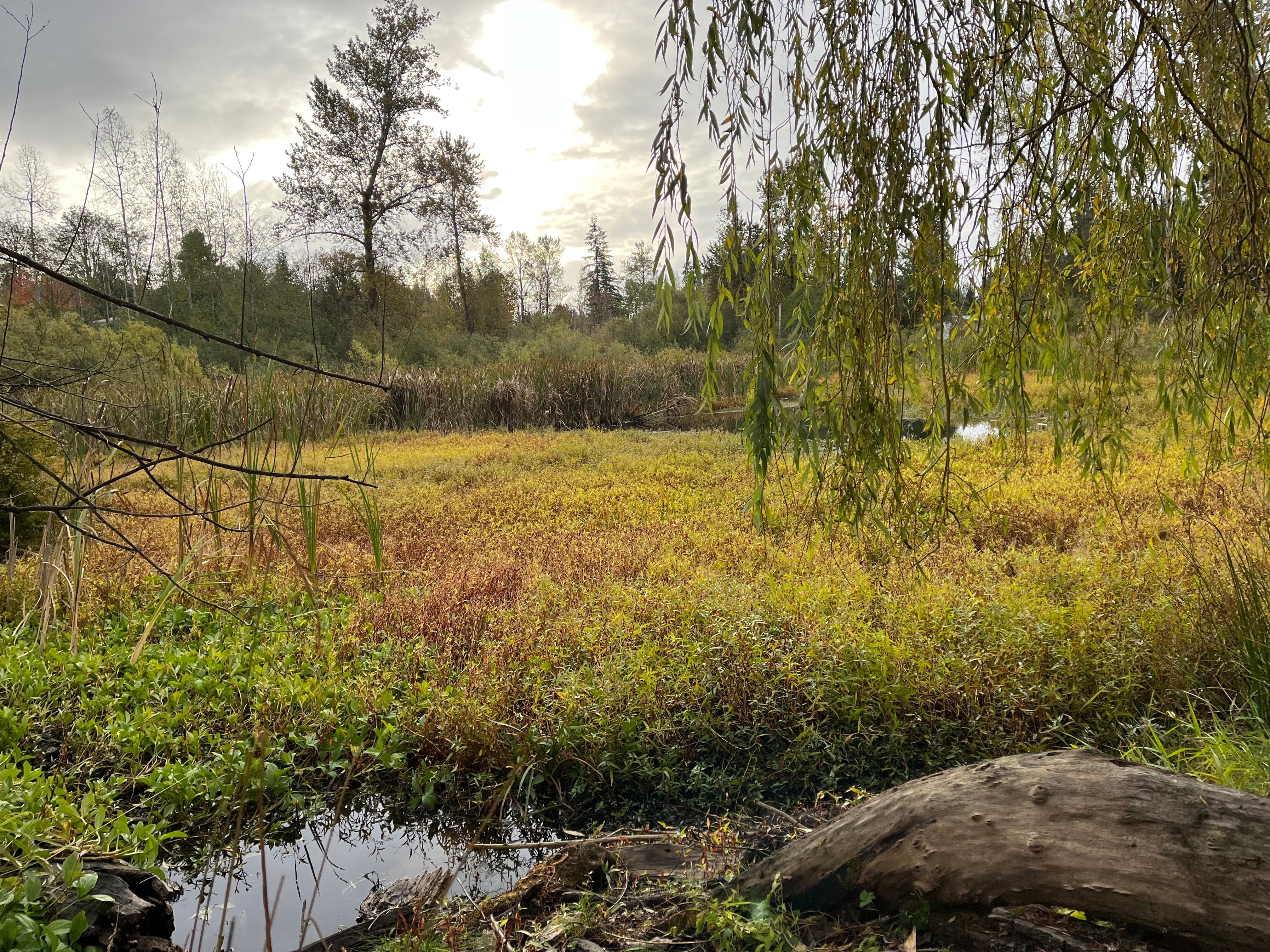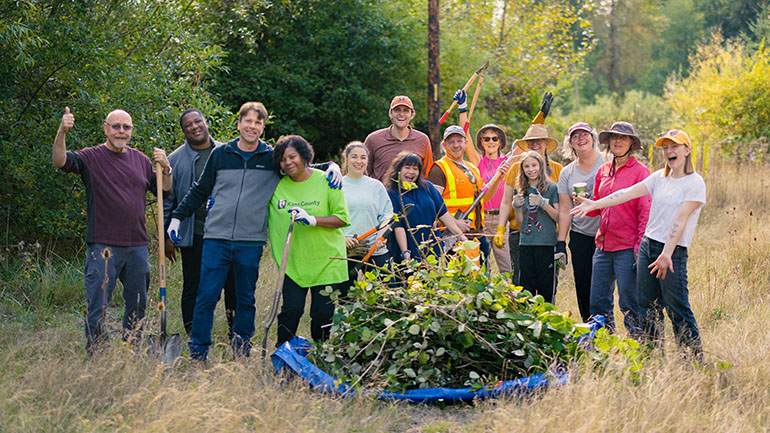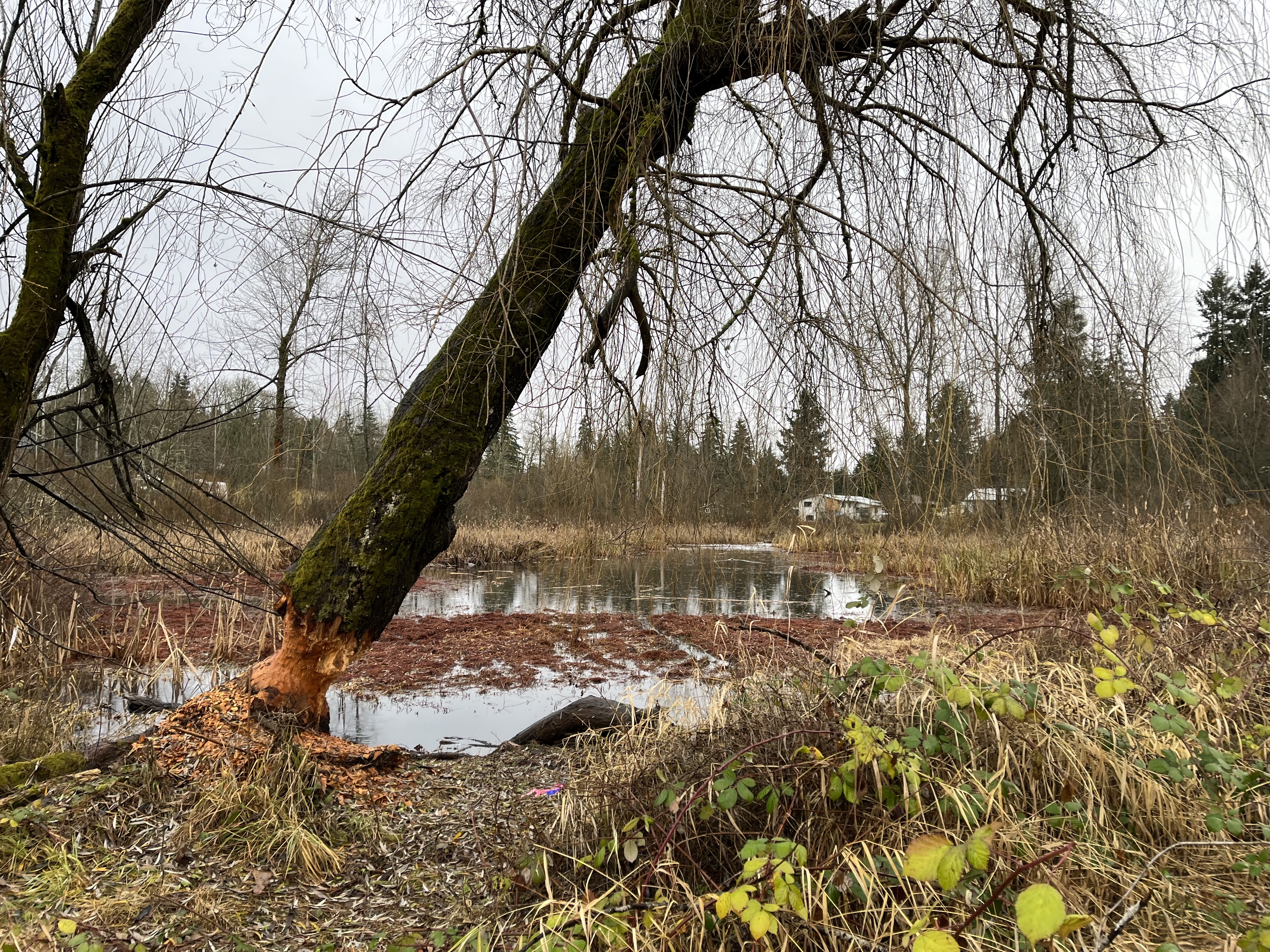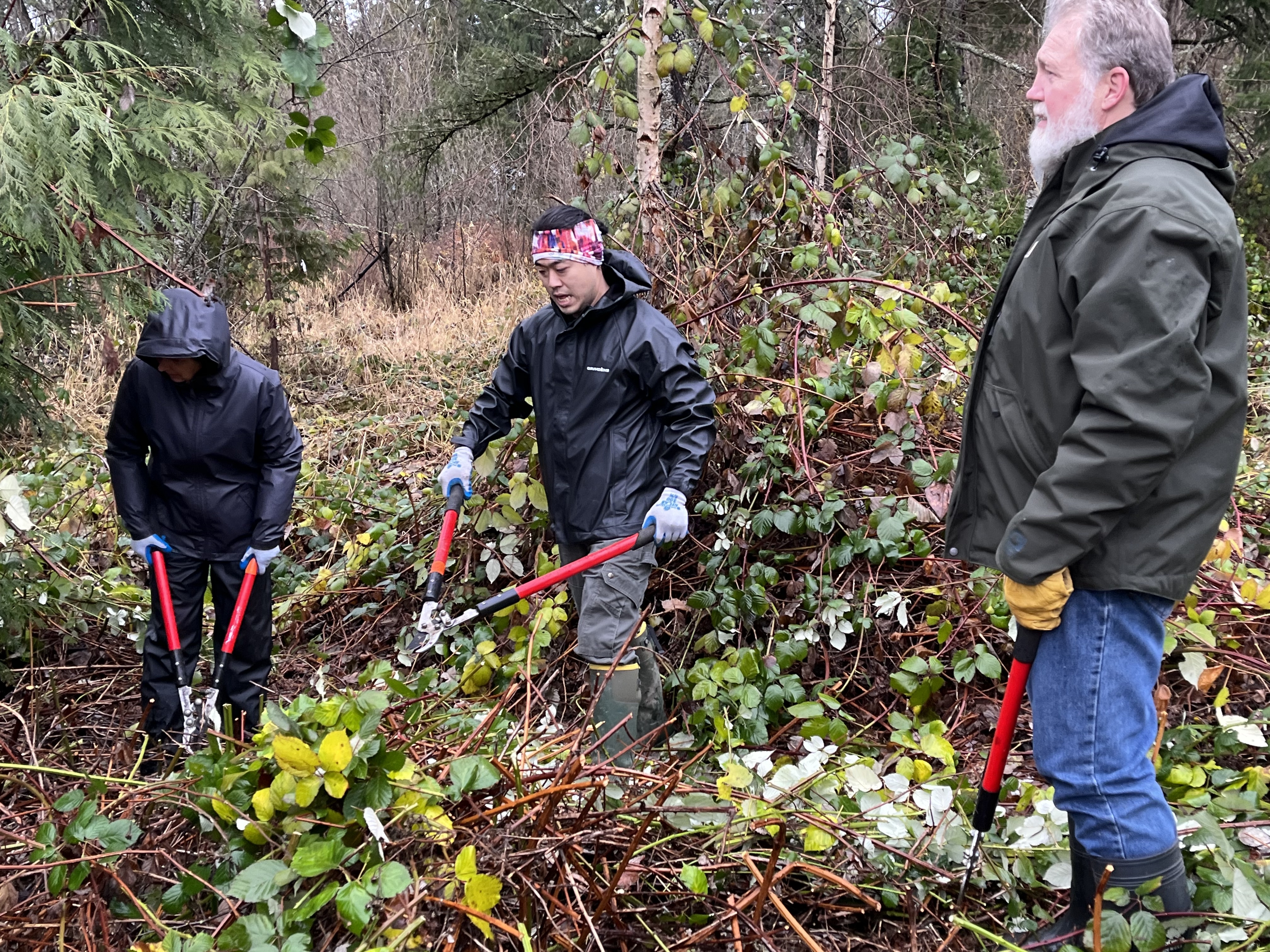Cemetery Pond Wetland Protection and Restoration
Background
May Creek is a stream where Chinook salmon begin their lives and return to spawn. Chinook salmon are a keystone species; a species that hold together the web of relationships in an ecosystem. They play a critical role in supporting and maintaining ecological health, are key to resident orcas’ diet and in the social fabric of First Nations and tribal culture. Chinook salmon (also known as king salmon) are listed as threatened under the Endangered Species Act.

Cemetery Pond wetland in October 2022.
As a natural floodplain, May Valley historically experiences periodic flooding. Flooding has worsened in the valley as climate change has made local weather patterns more intense, and development has increased impervious surfaces, increasing stormwater flows to Cemetery Pond and May Creek.
Development activities in May Valley have degraded stream and wetland habitats. Almost every one of the basin’s nearly 80 identified wetlands have been disturbed by deforestation, filling with soil or other material, draining, agricultural practices, or buffer removal. Filling wetlands increases stormwater runoff, peak stream flows, and sediment and pollutant runoff to streams, causing the decline of local habitat. Over time, approximately two acres of the Cemetery Pond wetland area was filled.
Cemetery Pond has a direct influence on water quality and habitat downstream. The 2001 May Creek Basin Action Plan (1.7 MB) recommended enhancing and restoring the Cemetery Pond wetland at the headwaters of May Creek near SE 128th and 165th Ave SE, Renton, WA.

Find out more about the project and how to get involved from a recent King County noxious weed blog post.
Our design team is available to attend community meetings, schools, or other events in the broader May Creek and Cemetery Pond wetland areas. Do you have a meeting you'd like us to come to? Invite us to attend at mmcnair@kingcounty.gov.
Value of restoration and protection
The table below gives examples of why it is important to protect and restore the Cemetery Pond wetland.
| Problem | Benefits achieved by restoring the natural wetland |
|---|---|
| Flooding and pollution |
|
| Degraded habitat for salmon and other wildlife |
|
| Equitable access to greenspace and parks |
|
| Climate Change |
|

Cemetery Pond wetland in December 2022.
King County has acquired properties from interested landowners adjacent to Cemetery Pond. The 30% (and pending final) design for restoring the wetland areas previously filled for development is available.
Community involvement is fundamental to Cemetery Pond wetland restoration and preservation work.
- Since 2007, local partners and residents have actively maintained and advocated for Cemetery Pond.
- The community, neighbors and volunteers from the Community Alliance to Reach out and Engage (C.A.R.E) continue to help restore the habitat by removing invasive weeds in the Cemetery Pond Wetland.
- For information about getting involved with C.A.R.E maintenance at the Cemetery Pond, contact highlands_neighbors@hotmail.com.
Investigation, design, and permitting phase
The County started the site investigation, design, and permitting phase of this effort to protect and restore the wetland in 2022. This phase will improve stormwater management by designing options to remove about two acres of historic fill.
The goal is to expand the wetland and restore required planting buffers while reducing maintenance cost through sustainable design practices and community stewardship.
The existing wetland is approximately 7.6 acres with 5.4 acres of buffer. The project will remove about two acres of fill, depending on the results of community co-design, permitting, and construction funding.
Project goals
- Help restore the wetland. The project will restore the natural functions of soils and native plants that help slow and absorb rainfall, reduce flooding, and provide habitat and green space.
- Provide amenities for the community. During development of the design, the County will work with neighbors and the community on the design of stormwater park amenities for the Cemetery Pond wetland restoration. The project will consider improved public access, and stormwater park amenities (educational signs, benches, waste bins, etc.).
- Create a stewardship plan for long term maintenance of the wetland area. Continued community stewardship will improve habitat by removing invasive species from the wetland and buffer to help native plants thrive and supporting a high-functioning wetland habitat. We welcome participation in the protection, restoration and maintenance of this important wetland.
- Expanded protection through continued property acquisitions with interested landowners. If you are interested in discussing the sale of your property with King County please contact King County Open Space Acquisitions. We are committed to reaching out to neighborhood property owners and other interested partners.

Timeline
| Project benchmark | Community engagement | Timing |
|---|---|---|
| Site investigation | N/A | October 2022 - March 2023 |
| 30% project design | Community kickoff meeting and onsite work party | December 10, 2022 |
| Onsite work party | June 10, 2023 | |
| Community input design open house | August 22, 2023 | |
| 90% project design | Onsite work party | October 28, 2023 |
| Final project design | Onsite work party | June 29, 2024 |
| State Environmental Policy Act (SEPA) | September 2024 | |
| Onsite work party | October 19, 2024 | |
| Community open house | May 14, 2025 | |
| Final permitting | Onsite work party | 2025 (TBD)* |
| 100% project design | N/A | August 2025 |
| Construction | N/A | Spring 2026 – Spring 2027** |
| Open to public | Stormwater Park opening | Summer 2027 – 2028*** |
| Maintenance | Onsite work party opportunities | Ongoing |
*Announcements for community work parties and design input sessions will be sent through email.
Sign up for project updates to your email or mobile phone.
**Contingent on funding and permits
***Contingent on plant establishment
Partnerships
- Key community partners include the Community Alliance to Reach out and Engage (C.A.R.E), a group associated with the Four Creeks Unincorporated Area Council organization, other community groups, local residents, and neighbors.
- This project is funded by:
- Washington State Department of Ecology Stormwater Financial Assistance Program and Centennial Clean Water Program grants
- King County Transfer of Development Rights (TDR)
- King County Conservation Futures (CFT)
- King County Parks Levy
- King County Department of Local Services Participatory Budget
- King County Surface Water Management (SWM) Fee
- King County’s Community Investment Budget Committee awarded the Cemetery Pond wetland restoration project:
- $54,000 in funding to support the future installation of interpretive signs near wetland ponds to educate the community about preserving the wetland and providing public access and amenities. (2024)
- $85,000 in funding to support continued acquisitions of the wetland and its buffer, which supported a parcel purchase. This funding helped add more than an acre to the wetland restoration project site. Learn more about the Community Investment Budget Committee's involvement with this Cemetery Pond project in this video.
- Lake Washington/Cedar/Sammamish Watershed (WRIA 8)
- The Cedar River, Issaquah Creek Basin Steward, Judy Blanco, works with residents to answer questions about best management practices, regulations, wildlife concerns, land conservation, habitat restoration, and water quality concerns. For more information, email jublanco@kingcounty.gov or call Judy Blanco at 206-263-8445.
We welcome the community’s partnership to advance stewardship of this critical natural resource and will continue reaching out to neighbors to encourage participation in the restoration and maintenance of this wetland.
Related information
- 2001 May Creek Basin Action Plan (1.7 MB)
- May Creek Water Quality Monitoring
- Cedar River-Lake Washington watershed
- Water Resource Inventory Area (WRIA) 8
- King County Noxious Weeds Program
- King County information and resources for beaver management
- King County Clean Water & Healthy Habitat
- Stormwater Parks

 Translate
Translate